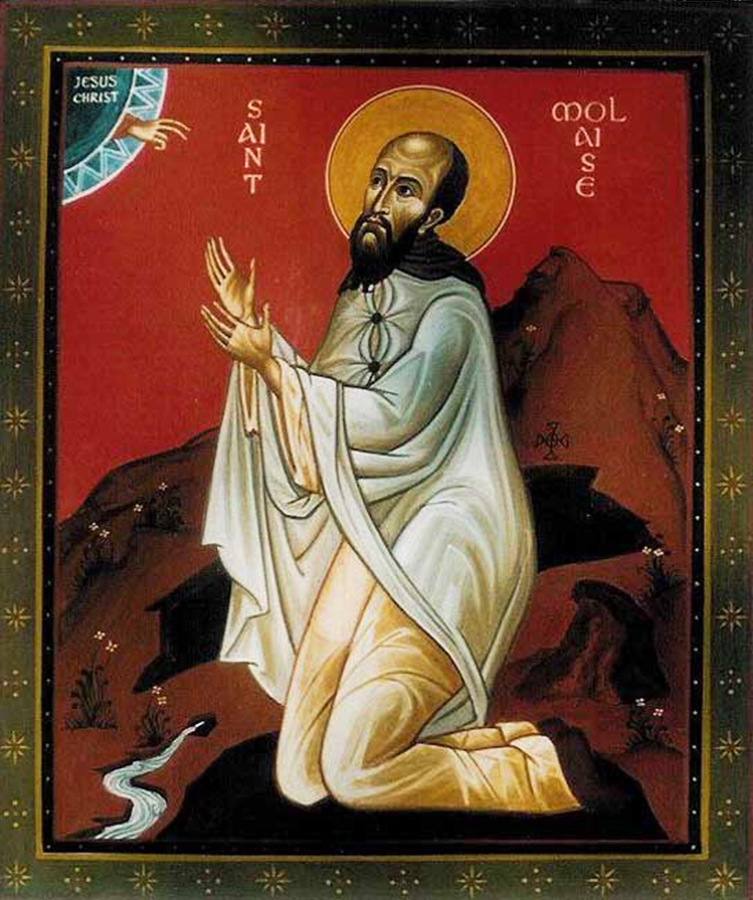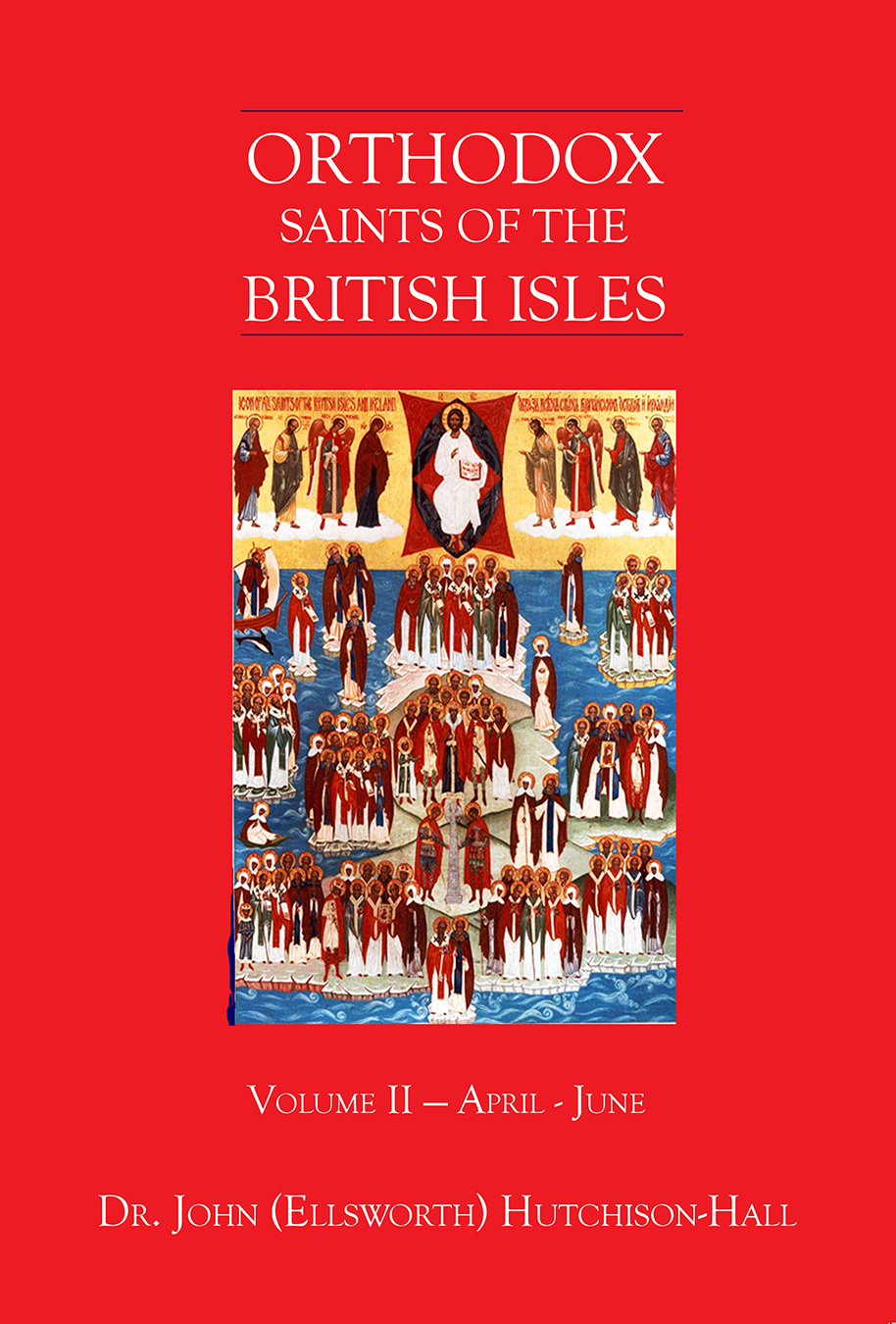
Orthodox Saints of the Pre-Schism
See of Rome
1st May (NS) — 18th April (OS) 2023
AGIA (AIA, AUSTREGILDIS, AYE), the wife of St. Hidulf of Hainaut (23rd June). She and St. Hidulf separated by mutual consent to enter monastic life. St. Agia entered an abbey in Mons (Hainaut, Belgium) where she lived until her repose circa 714.
APOLLONIUS the APOLOGIST, a Roman senator and scholar who, after studies in pagan philosophy as well as the Scriptures converted to Christianity. Though during the time in which St. Apollonius flourished Christians were relatively free from persecution, when one of his servants denounced St. Apollonius to the authorities. St. Apollonius was then brought before a court which gave him the option of either renouncing Christianity or death, St. Apollonius refused to apostatise and was beheaded circa 190. Eusebius of Caesarea (†339) in his Ecclesiastical History, and St. Jerome (30th September) in De Viris Illustribus have written of St. Apollonius and his trial.
BITHEUS and GENOCUS, (Sixth Century), Two British monks, who accompanied St. Finian of Clonard (12th December) to Ireland where they gained reputations for great sanctity and eventually reposed. There is no further information on either saint extant.
CALOCERUS, (Date Uncertain), an officer in the army of the Emperor Hadrian (r. 117–138) who was martyred in Brescia, Lombardy (northern Italy) for converting to Christianity.
COGITOSUS, (Seventh or Eighth Century), though little is known of this saint, it appears he was a monk at St. Bridig's monastery in Co. Kildare, Ireland. The Vita Sanctae Brigitae (Brigidae), generally thought to be the oldest extant Life of St. Brigid (1st February) is generally ascribed to St. Cogitosus. Some sources contend that he may have been related to St. Brigid as well, though there is insufficient evidence to support this assertion.
COREBUS, according to pious legend St. Corebus was a prefect in Messina, Sicily who was converted to Christ by the witness of St. Eleutherius (26th May). He was martyred in 138, a victim of the persecutions during the reign of Emperor Hadrian (r. 117–138).
DEICOLA (DICUL), A native of Ireland, St. Deicola went to England where he worked to enlighten the people of Norfolk and Sussex. The village of Dickleburgh in South Norfolk may be named after him. He reposed towards the end of the seventh century.
ELEUTHERIUS and ANTHIA, St. Eleutherius, Bishop of Illyria in present-day Croatia, his mother Anthia, and eleven others, whose name are no longer known, were martyred, possibly for their successful evangelisation, in Illyria circa 138, in the persecutions during the reign of Emperor Hadrian (r. 117–138).
LASERIAN (MOLAISSE) of LEIGHLIN, A nephew of St. Blane (10th August), St. Laserian is said to have been ordained to the priesthood in Rome by Pope St. Gregory the Dialogist (3rd September). Upon returning to Ireland he founded the monastery and Bishopric of Leighlin, Co. Carlow, serving as the first Bishop-Abbot. Soon afterwards he was appointed Papal Legate to Ireland, and, in that role, strenuously advocated for the Roman Practices to prevail, especially with regards to Easter (vide Paschal Controversy). St. Laserian is also venerated as the Patron of the Roman Catholic Diocese of Leighlin.
PERFECTUS (PERFECTO), a priest in Córdoba who was martyred by Muslims for expressing the opinion that Jesus was the Son of God and our Saviour, while Mohammed was a false prophet. Following his arrest and conviction for blasphemy, St. Perfectus was executed on Easter Sunday 851.
WICTERP (WIGBERT, WIHO, WICHO), Abbot of Ellwangen Abbey (Kloster Ellwangen) in Swabia (present-day Ellwangen an der Jagst, Baden-Württemberg, Germany). He also founded eminent monasteries at Füssen, Wessobrunn, and Kempten all in Bavaria. St. Wicterp was consecrated the twelfth Bishop of Augsburg, Bavaria (Germany) circa 738, serving until his repose in 749.
Get your copy of Orthodox Saints of the British Isles today.
Available at Amazon or your favourite e-bookstore.
ACIUS (ACHE) and ACEOLUS (ACHEUL), Martyrs of Amiens, SS. Acius and Aceolus were martyred circa 303 near Amiens in Gaul (France) during the Diocletianic Persecution.
AMATOR (AMATRE, AMADOUR) of AUXERRE, the (fourth) Bishop of Auxerre in Burgundy (France) from 388 until his repose in 418. After their wedding, he and his wife (venerated locally as St. Martha), mutually agreed to live together as brother and sister. Later St. Amator entered holy orders and his wife received monastic tonsure. St. Amator was known as a wonderworker. One of his episcopal acts as Bishop was ordaining St. Germanus of Auxerre (31st July) to the priesthood. St. Germanus later succeeded St. Amator in the See of Auxerre.
ANDEOLUS of SMYRNA, a sub-deacon and disciple of St. Polycarp of Smyrna (23rd Feb) who sent St. Andeolus to evangelise in Gaul (France). After a very fruitful forty-two years of spreading the Gospel, in 208 St. Andeolus was arrested, scourged, and beheaded.
ARIGIUS (AREY) of GAP, the eighth Bishop of Gap, in Province (France), St. Arigius served that See for twenty years. During his time as Bishop, St. Arigius worked with St. Columbanus of Luxeuil (23rd November) to achieve uniformity in the calculation of the date of Easter. St. Arigius reposed in 604.
ASAPH of LLANELWY, (Sixth Century), St. Asaph was the second Abbot-Bishop of the monastery and diocese now called St. Asaph in Denbighshire, north Wales, and its first native Welshman to hold that position. Prior to his consecration as bishop, he had been a disciple of St. Kentigern Mungo (13th January) during the latter’s exile in Wales. Whilst Abbot, St. Asaph governed close to one thousand monks, many of whom served the diocese’s parishes. Nothing more is definitely known of this saint, including the exact year of his repose.
BENEDICT of SZKALKA, a disciple of St. Andrew Zorard (17th July) at the Abbey of Saint Hippolyte on Mount Zabor near Nitra in present-day western Slovakia, and anchorite renowned for his asceticism, St. Benedict was murdered by a gang of bandits who believed he had hidden treasure in his cave in 1012.
BERTHA of KENT, the wife of St. Gundebert of Gumber (29th April). She and her husband separated by mutual consent in order to enter monastic life. St. Bertha received monastic tonsure and founded an abbey at Avenay in Normandy (France). St. Bertha was murdered by her in-laws for distributing St. Gundebert’s estate to the poor, circa 685, and hence considered a martyr.
BRIEUC (BRIOCUS, BRIOC) of BRITTANY, born to a pagan Welsh noble family, St. Brieuc converted to Christianity as a young adult. He then went to Brittany (France) where he was ordained to the priesthood, following tutelage under St. Germanus of Auxerre (31st July), St. Brieuc set off to his native Wales where he spent some time evangelising in the Cardigan area. He returned to Brittany where he founded two monasteries, and later served as a bishop in upper-Brittany. St. Brieuc reposed circa 510 at the village later named for him, present-day Saint-Brieuc-des-Iffs, Brittany, France.
CEALLACH (KELLACH) of KILLALA, (Sixth Century), it is generally believed that St. Ceallach was a disciple of St. Kieran of Clonmacnoise (9th September). He served as the first Bishop of Killable, in Co. Mayo, Ireland, though he resigned his See and ended his life as a hermit. It is possible he may have been martyred, though the limited information that exists on this saint is full of discrepancies, and it is possible his existence is apocryphal.
COMINUS of CATANIA, (Date Uncertain), a martyr in Catania, Sicily of whom there is no further information.
EVERMARUS of ROUSSON, a pilgrim murdered by thieves in Rousson near Tongres (present-day eastern Belgium) circa 700.
GRATA of BERGAMO, (Fourth or Eighth Century), a holy woman from Bergamo in Lombardy (Italy) who dedicated herself to good works, especially arranging Christian burials for martyrs.
MARCULF (MARCULPHUS), after a very successful time bringing pagans to Christ, St. Marculf retired to the wilderness seeking to live a hermetical life. As is generally the case, his solitude was short as he attracted many disciples for whom he founded a monastery at Nanteuil in Aquitaine (France). St. Marculf reposed in 558. It has been written that after touching the relics of St. Marculf, the Kings of France were able to cure Scrofula.
ORENTIUS (ORIENTIUS) of AUCH, an anchorite in the Lavendan Valley (vallées des Gaves in present-day France). St. Orentius was so renowned for holiness of life, that the people of Auch insisted on having him for their bishop, even though he truly desired to remain a hermit. St. Orentius served the See of Auch over forty years, reposing circa 439.
ORENTIUS and PATIENTIA, Martyrs of Loret, a husband and wife who lived near Huesca in Spain, who, according to an old Spanish tradition, were the parents of St. Laurence the Martyr (10th August). SS. Orentius and Patientia reposed circa 240.
SIGISMUND of BURGUNDY, son of the Arian Gundobad, King of the Burgundians (r. 473–516). St. Sigismund succeeded his father on the throne in 516. A disciple of St. Avitus of Vienne (5th February), St. Sigismund also founded the Abbey of Saint-Maurice (abbaye de Saint-Maurice d'Agaune) at Agaune in Valais, Switzerland. Though a Christian, St. Sigismund’s temperament was true to his pagan Vandal roots. And as he grew older St. Sigismund repented and withdrew to the Abbey of Saint-Maurice. During the invasion of the Franks in 523 St. Sigismund led troops into battle, but was captured and taken to Orléans where he was murdered, and subsequently venerated by his subjects as a martyr.
THEODARD (AUDARD) of NARBONNE, born into a wealthy noble family, and educated at the Abbey of St. Martin (abbaye Saint-Martin) in Montauriol, in present-day Occitanie, France. St. Theodard received monastic tonsure at St. Martin Abbey, and spent a great deal of time ministering to those less fortunate in the Diocese of Narbonne. In 885, St. Theodard was consecrated Archbishop of Narbonne (southern France) serving that See until his repose in 893. Following his repose, the Abbey of St. Martin was re-named St. Audard after him.
Prior to the Schism the Patriarchate of Rome was Orthodox, and fully in communion with the Orthodox Church. As Saint John of Shanghai and San Francisco +1966 said “The West was Orthodox for a thousand years, and her venerable Liturgy is far older than any of her heresies”.
Details of British Saints excerpted from Orthodox Saints of the British Isles.
Details of continental saints from these sources.
In many cases there are several spelling versions of the names of saints from the British Isles. I use the Oxford Dictionary of National Biography version as the primary version with the more prevalent version in parenthesis e.g. Ceadda (Chad) of Lichfield.


